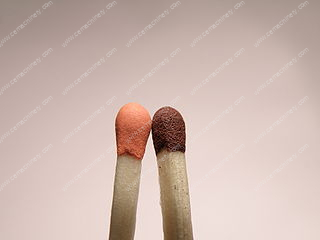Christmas Lights – the invention of matches
It is Christmastime, and the season of light: everywhere you look, particularly after dark, is the twinkle of hundreds of little lights. As 2015 approaches, the International Year of Light is also being kindled into action – a year designed to make us think about light technologies and global challenges in energy. So let’s start now, and out of the dark.
One of the earliest human light technologies was the match. What do you need to make fire? Oxygen, fuel and an ignition source – simple enough in theory, but not so much in practice. Fires just don’t start spontaneously. Before matches, ignition sources included flint and tinder, or a magnifying glass which, naturally, only worked on sunny days, when you are least in need of fire. But luckily, something was spontaneous: the accidental invention of matches.
Matches had nearly been discovered more than once. Having synthesised phosphorous in 1680, Robert Boyle showed awestruck onlookers how this new material created fire when rubbed with sulfur, but the combustion exercise was never put to practical use and remained merely entertainment for wealthy dabblers. He wasn’t the first to make such novelties either – as far back as 950 AD, Chinese ‘Records of the unworldly and strange’ mention ‘light-bringing slaves’ (later ‘fire-inch sticks’) that use sulfur to create fire fast from a small spark or dying embers. In 1805, a French chemist, Jean Chancel, dipped a wooden splint in sugar, potassium chlorate, and sulfuric acid, creating an explosion. It was expensive, dangerous and gave off a foul, poisonous odour. But all of these were chemical matches: they required mixing the right things together at the right time to create an exothermic reaction. The first friction match was created by accident, by apothecary John Walker in 1826.
The fact that wooden splints were so ubiquitous in chemical exploration meant that the invention of the match was almost inevitable. Walker had been stirring away at a pot containing antimony sulfide, potassium chlorate, starch and gum, when he found a mixture of these chemicals had dried onto the end of his wooden stirring stick. Inconvenienced, he removed the stick and started scraping off the dried lump on the stone floor of the lab, but to his astonishment, the chemicals set alight! The match is actually a delicate piece of technology that exists around a chemical balance: a mixture of materials that are stable and solid, but light readily upon agitation.
Excited, Walker repeated the experiment, and made more sticks. Soon he had many: first made of cardboard and then of three-inch wooden sticks. Proving them in a box with handy piece of sandpaper, he started selling his invention as ‘friction lights’ or ‘Congreve’s’ after William Congreve’s new rocket. He was advised to patent the matches – but didn’t, hoping the idea would spread and the technology enhance people’s lives. The idea certainly did spread, although the new matches were mostly used to light pipes and fuel tobacco intake. Walker’s Congreve’s didn’t corner the market. Samuel Jones saw Walker demonstrate his matches in London, and upon hearing that Walker did not intend to patent his idea, created his own smaller matches, named ‘Lucifers’.
These unpredictable little beasts were not only too easily ignited, but they burnt with a nasty odour and stream of unpleasant phosphorus-based chemicals. The box even carried a warning for ‘persons whose lungs are delicate’. Another French chemist, Charles Sauria, used white phosphorus to create matches without a detectable odour. He also used child labour to set up massive factories, spewing out huge mountains of matches. Soon, large numbers of factory workers were unwell, poisoned by the white phosphorous and deformed by a bone-mutilating illness known as ‘phossy jaw’. Even one box of matches contained enough toxic phosphorus to kill a man. Murder and suicide by matches became established.
It was not until the 1888 London matchgirls’ strike that any legislation was passed restricting the use of white phosphorus, but by this time another kind of match had become available: the safety match. Patented by Johan Edvard Lundström in Sweden in 1855, safety matches used non-toxic red phosphorous and placed the sandpaper on the outside of the match box, creating a much safer product. Lundström’s was not the only company to produce the new type, and soon people were striking matches all around the world and celebrating the dawn of a new light.
Read More: Wooden Match Sticks Making Machine


